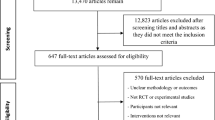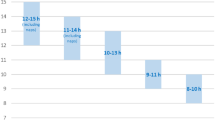Abstract
Purpose
Sleep-disordered breathing (SDB) prevalence peaks in preschool children and is associated with deficits in cardiovascular functioning during sleep. No long-term studies have investigated the effects of SDB resolution in mitigating these outcomes. We hypothesized that following 3 years, normalization of alterations to heart rate (HR), pulse transit time (PTT), heart rate variability (HRV), and urinary catecholamines identified at the initial diagnosis would be associated with resolution of SDB.
Methods
Forty-five children with SDB and 28 non-snoring controls underwent polysomnography at baseline (3–5 years) and follow-up (6–9 years). Children were classified into control, resolved, and unresolved SDB. Resolution was defined as an obstructive apnea–hypopnea index (OAHI) ≤1 event/h, no snoring on polysomnography (PSG), or indicated by parents. PTT is an inverse surrogate measure of blood pressure change. HRV was assessed using power spectral analysis.
Results
There was no change in PTT or HR between studies for any group. Our HRV data suggest reduced parasympathetic activity in children whose SDB resolved and increased parasympathetic activity in children whose SDB remained the same or worsened at follow-up. We identified a significant correlation between low frequency power and urinary dopamine and adrenaline levels at follow-up in the unresolved group, suggesting increased sympathetic activity in children with unresolved SDB.
Conclusion
Our findings suggest an association between resolution of SDB and normalization of HRV in the long term in these preschool children and an augmented sympathetic activity in the children with residual SDB. This highlights the autonomic impact of SDB in young children and the importance of detection and treatment.






Similar content being viewed by others
References
Mindell JA, Owens JA (2010) Sleep-disordered breathing and obstructive sleep apnea syndrome. In: Pediatric sleep: diagnosis and management of sleep problems. Lippincott Williams and Wilkins, a Wolters Kluwer Health business, Philadelphia, pp 100–115
Gozal D, Kheirandish-Gozal L (2012) Childhood obesity and sleep: relatives, partners, or both?—a critical perspective on the evidence. Ann N Y Acad Sci 1264:135–141
Jeans WD, Fernando DC, Maw AR, Leighton BC (1981) A longitudinal study of the growth of the nasopharynx and its contents in normal children. Br J Radiol 54:117–121
Katz ES, D’Ambrosio CM (2008) Pathophysiology of pediatric obstructive sleep apnea. Proc Am Thorac Soc 5:253–262
Marcus CL, Brooks LJ, Draper KA et al (2012) Diagnosis and management of childhood obstructive sleep apnea syndrome. Pediatrics 130:e714–e755
Horne RS, Yang JS, Walter LM et al (2011) Elevated blood pressure during sleep and wake in children with sleep-disordered breathing. Pediatrics 128:e85–e92
Li AM, Au CT, Ho C, Fok TF, Wing YK (2009) Blood pressure is elevated in children with primary snoring. J Pediatr 155:362–368 e1
Leung LC, Ng DK, Lau MW et al (2006) Twenty-four-hour ambulatory BP in snoring children with obstructive sleep apnea syndrome. Chest 130:1009–1017
Kwok KL, Ng DK, Cheung YF (2003) BP and arterial distensibility in children with primary snoring. Chest 123:1561–1566
Amin R, Somers VK, McConnell K et al (2008) Activity-adjusted 24-hour ambulatory blood pressure and cardiac remodeling in children with sleep disordered breathing. Hypertension 51:84–91
Walter LM, Nixon GM, Davey MJ, Anderson V, Walker AM, Horne RS (2012) Autonomic dysfunction in children with sleep disordered breathing. Sleep Breath. doi:10.1007/s11325-11012-10727-x
Liao D, Li X, Rodriguez-Colon SM et al (2010) Sleep-disordered breathing and cardiac autonomic modulation in children. Sleep Med 11:484–488
Chaicharn J, Lin Z, Chen ML, Ward SL, Keens T, Khoo MC (2009) Model-based assessment of cardiovascular autonomic control in children with obstructive sleep apnea. Sleep 32:927–938
McConnell K, Somers VK, Kimball T et al (2009) Baroreflex gain in children with obstructive sleep apnea. Am J Respir Crit Care Med 180:42–48
Walter LM, Yiallourou SR, Vlahandonis A et al. (2013) Impaired blood pressure control in children with obstructive sleep apnea. Sleep Med
O’Driscoll DM, Horne RS, Davey MJ et al (2011) Increased sympathetic activity in children with obstructive sleep apnea: cardiovascular implications. Sleep Med 12:483–488
Nisbet LC, Yiallourou SR, Biggs SN et al (2013) Preschool children with obstructive sleep apnea: the beginnings of elevated blood pressure? Sleep 36:1219–1226
Nisbet LC, Yiallourou SR, Nixon GM et al (2013) Nocturnal autonomic function in preschool children with sleep-disordered breathing. Sleep Med 14:1310–1316
Nisbet LC, Yiallourou SR, Nixon GM et al (2013) Characterization of the acute pulse transit time response to obstructive apneas and hypopneas in preschool children with sleep-disordered breathing. Sleep Med 14:1123–1131
O’Driscoll D, Foster AM, Ng ML et al (2009) Acute cardiovascular changes with obstructive events in children with sleep disordered breathing. Sleep 32:1265–1271
Khayat R, Patt B, Hayes D Jr (2009) Obstructive sleep apnea: the new cardiovascular disease. Part I: obstructive sleep apnea and the pathogenesis of vascular disease. Heart Fail Rev 14:143–153
Gozal D, Kheirandish-Gozal L, Serpero LD, Sans Capdevila O, Dayyat E (2007) Obstructive sleep apnea and endothelial function in school-aged nonobese children: effect of adenotonsillectomy. Circulation 116:2307–2314
Peppard PE, Young T, Palta M, Skatrud J (2000) Prospective study of the association between sleep-disordered breathing and hypertension. N Engl J Med 342:1378–1384
Montesano M, Miano S, Paolino MC et al (2010) Autonomic cardiovascular tests in children with obstructive sleep apnea syndrome. Sleep 33:1349–1355
O’Brien LM, Gozal D (2005) Autonomic dysfunction in children with sleep-disordered breathing. Sleep 28:747–752
Amin R, Anthony L, Somers V et al (2008) Growth velocity predicts recurrence of sleep-disordered breathing 1 year after adenotonsillectomy. Am J Respir Crit Care Med 177:654–659
Ng DK, Wong JC, Chan CH, Leung LC, Leung SY (2010) Ambulatory blood pressure before and after adenotonsillectomy in children with obstructive sleep apnea. Sleep Med 11:721–725
Vlahandonis A, Nixon GM, Davey MJ, Walter LM, Horne RS (2013) Improvement of sleep-disordered breathing in children is associated with a reduction in overnight blood pressure. Sleep Med 14:1295–1303
Constantin E (2008) Pulse rate and pulse rate variability decrease after adenotonsillectomy for obstructive sleep apnea. Pediatr Pulmonol 43:498–504
Vlahandonis A, Yiallourou SR, Sands SA et al (2014) Long-term changes in blood pressure control in elementary school-aged children with sleep-disordered breathing. Sleep Med 15:83–90
Vlahandonis A, Yiallourou SR, Sands SA et al (2014) Long-term changes in heart rate variability in elementary school-aged children with sleep-disordered breathing. Sleep Med 15:76–82
Muzumdar HV, Sin S, Nikova M, Gates G, Kim D, Arens R (2011) Changes in heart rate variability after adenotonsillectomy in children with obstructive sleep apnea. Chest 139:1050–1059
Apostolidou MT, Alexopoulos EI, Damani E et al (2008) Absence of blood pressure, metabolic, and inflammatory marker changes after adenotonsillectomy for sleep apnea in Greek children. Pediatr Pulmonol 43:550–560
Ogden C, Kuczmarski R, Flegal K et al (2002) Centers for Disease Control and Prevention 2000 growth charts for the United States: improvements to the 1977 National Center for Health Statistics version. Pediatrics 109:45–60
Walter LM, Nixon GM, Davey MJ, O’Driscoll DM, Trinder J, Horne RS (2011) Sleep disturbance in pre-school children with obstructive sleep apnoea syndrome. Sleep Med 12:880–886
Biggs S, Walter LM, Embulden U et al (2012) Time course of EEG slow-wave activity in pre-school children with sleep disordered breathing: a possible mechanism for daytime deficits? Sleep Med 13:999–1005
Iber C, Ancoli-Israel S, Chesson A, Quan SF, The AASM (2007) Manual for the scoring of sleep and associated events: rules, terminology and technical specification, 1st edn. American Academy of Sleep Medicine, Westchester
Nixon GM, Hyde M, Biggs SN, Walter LM, Horne RS, Davey MJ (2014) The impact of recent changes to the respiratory scoring rules in pediatrics. J Clin Sleep Med 10:1217–1221
Payne RA, Symeonides CN, Webb DJ, Maxwell SR (2006) Pulse transit time measured from the ECG: an unreliable marker of beat-to-beat blood pressure. J Appl Physiol 100:136–141
Task Force of the European Society of Cardiology and the North American Society of Pacing and Electrophysiology (1996) Heart rate variability, standards of measurement, physiological interpretation, and clinical use. Eur Heart J 17:354–381
Kaditis AG, Alexopoulos EI, Damani E et al (2009) Urine levels of catecholamines in Greek children with obstructive sleep-disordered breathing. Pediatr Pulmonol 44:38–45
Snow AB, Khalyfa A, Serpero LD et al (2009) Catecholamine alterations in pediatric obstructive sleep apnea: effect of obesity. Pediatr Pulmonol 44:559–567
Laskar SM, Iwamoto M, Nakamoto M, Koshiyama H, Harada N (2004) Heart rate variation and urinary catecholamine excretion in response to acute psychological stress in hand-arm vibration syndrome patients. J Occup Health 46:125–131
Walter LM, Biggs SN, Nisbet LC et al. Long-term improvements in sleep and respiratory parameters in preschool children following treatment of sleep disordered breathing. J Clin Sleep Med In Press
Marcus CL (2001) Sleep-disordered breathing in children. Am J Respir Crit Care Med 164:16–30
Verginis N, Jolley D, Horne RS, Davey MJ, Nixon GM (2009) Sleep state distribution of obstructive events in children: is obstructive sleep apnoea really a rapid eye movement sleep-related condition? J Sleep Res 18:411–414
Goldstein DS, Bentho O, Park MY, Sharabi Y (2011) Low-frequency power of heart rate variability is not a measure of cardiac sympathetic tone but may be a measure of modulation of cardiac autonomic outflows by baroreflexes. Exp Physiol 96:1255–1261
Baharav A, Kotagal S, Rubin BK, Pratt J, Akselrod S (1999) Autonomic cardiovascular control in children with obstructive sleep apnea. Clin Auton Res 9:345–351
Spicuzza L, Bernardi L, Calciati A, Di Maria GU (2003) Autonomic modulation of heart rate during obstructive versus central apneas in patients with sleep-disordered breathing. Am J Respir Crit Care Med 167:902–910
Gates GJ, Mateika SE, Mateika JH (2005) Heart rate variability in non-apneic snorers and controls before and after continuous positive airway pressure. BMC Pulm Med 5:9
Nisbet LC, Yiallourou SR, Walter LM, Horne RS (2013) Blood pressure regulation, autonomic control and sleep disordered breathing in children. Sleep Med Rev
Kaditis AG, Chaidas K, Alexopoulos EI, Varlami V, Malakasioti G, Gourgoulianis K (2011) Effects of adenotonsillectomy on R-R interval and brain natriuretic peptide levels in children with sleep apnea: a preliminary report. Sleep Med 12:646–651
Grassi G (2010) Sympathetic neural activity in hypertension and related diseases. Am J Hypertens 23:1052–1060
Kaditis A (1998) From obstructive sleep apnea in childhood to cardiovascular disease in adulthood: what is the evidence? Sleep 33:1279–1280
Moodithaya S, Avadhany ST (2012) Gender differences in age-related changes in cardiac autonomic nervous function. J Aging Res 2012:679345
Berenson GS, Srinivasan SR, Wattigney WA, Harsha DW (1993) Obesity and cardiovascular risk in children. Ann N Y Acad Sci 699:93–103
Kelly A, Dougherty S, Cucchiara A, Marcus CL, Brooks LJ (2010) Catecholamines, adiponectin, and insulin resistance as measured by HOMA in children with obstructive sleep apnea. Sleep 33:1185–1191
Acknowledgments
The authors would like to thank the children and families who participated in this study and the staff of the Melbourne Children’s Sleep Centre for their support.
Funding
This research was funded by the National Health and Medical Research Council of Australia project grant number APP1008919 and the Victorian Government’s Operational Infrastructure Support Program.
Author information
Authors and Affiliations
Corresponding author
Ethics declarations
Conflict of interest
All authors certify that they have no affiliations with or involvement in any organization or entity with any financial interest (such as honoraria; educational grants; participation in speakers’ bureaus; membership, employment, consultancies, stock ownership, or other equity interest; and expert testimony or patent-licensing arrangements) or non-financial interest (such as personal or professional relationships, affiliations, knowledge or beliefs) in the subject matter or materials discussed in this manuscript.
Rights and permissions
About this article
Cite this article
Walter, L.M., Biggs, S.N., Nisbet, L.C. et al. Improved long-term autonomic function following resolution of sleep-disordered breathing in preschool-aged children. Sleep Breath 20, 309–319 (2016). https://doi.org/10.1007/s11325-015-1268-x
Received:
Revised:
Accepted:
Published:
Issue Date:
DOI: https://doi.org/10.1007/s11325-015-1268-x




